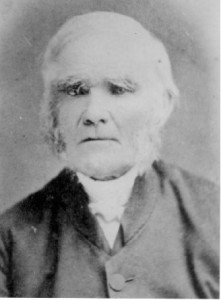
Rev. Robert Corson (1793-1878), Methodist Minister, Upper Canada. My Great Great Great Great Grand Uncle. Doesn't he look Irish?
It’s that time of year again. When I patronized my local Chick-Fil-A, I noticed that many people were drinking a mysterious green fluid. After a few minutes, I discovered that it was dyed lemonade. Then it hit me. It’s almost St. Patrick’s Day.
Everything turning green.
They dye the river green here. This is a tradition that was started by the plumbers back in 1962. Although to be quite honest, I believe that the Chicago River is green naturally and even sometimes a fluorescent turquoise. We’re not talking about something pretty. The Chicago Tribune in May 2011 quoted that a conservation group deemed the river to be one of the Nation’s most threatened waterways. This is because of the billions of partially treated human and industrial waste dumped into it daily. The good news is that it is in the process of being cleaned up. The bad news is that it will cost about half a billion.
Green with envy to be Irish
St. Patrick’s is one of those saints like St. Valentines and St. Nicholas, that seems to appeal to the general American public as well as the entrepreneurial at heart as can be evidenced by the prevalence of “green” stuff for sale. St. Patrick’s Day is when most search for an Irish gene or at least a pair of green jeans.
In researching for my own Irish roots, I found that my great great Grandmother, Lydia, on my father’s side was a “Corson” from Canada. The surname Corson is actually Scottish/Northern Irish in origin. In fact I discovered that my 4th great grand uncle, Rev. Robert Corson (1793-1878), was a Wesleyan Methodist Minister who was instrumental in bringing this particular denomination to Upper Canada – a missionary of sorts. There is an old biography (dated 1879) out there of him entitled, Father Corson, or The Old Style Canadian Itinerate: Embracing the Life and Gospel Labours of the Rev. Robert Corson, Fifty-Six Years A Minister in Connection with Central Methodism in Upper Canada. An old picture shows a stern looking man with bushy eyebrows.
In looking for some other Irish ancestry, family ancestors with the surname “Edgar” come close. My great great maternal grandmother Arabella Edgar whom I featured in my “Blooming Red Onion” post, may have had Scottish/Irish roots. However, according to my research only DNA can confirm the exact origin.
St. Pat was not even native Irish
One can see that I struggle to make a connection to any Irish roots. Well I can relax because actually the truth of the matter is that St. Patrick was not native Irish. He actually was born in Scotland around 385 A.D. and his parents were wealthy Romans (as in Italian). He was later kidnapped by pirates and made a slave in Ireland. It was during his captivity that he turned to God in prayer. He escaped at the age of 20 after God told him how to get away in a dream. However in another dream he heard the people of Ireland call out to him: “We beg you, holy youth to come and walk among us once more.” As a result he became a priest, then a bishop and took the Gospel to Ireland. He used the leaves of the shamrock plant which were abundant in Ireland to illustrate the concept of the Holy Trinity.
Spiritual contribution
For many these days, St. Patrick’s Day has little spiritual significance. St. Patrick’s Day often is hidden behind images of leprechauns and many use it as a rowdy excuse to drink green variations of alcohol in excess. In big cities it is often better to hide at home until all of the secular festivities are finished for fear of being broad sided by a drunk. In Chicago, when the weather is warmer, the number of shootings and homicides increase. Kind of puts a damper on the idea of a party.
However, St. Patrick has given us a deep spiritual legacy. The real St. Patrick exercised extreme humility and was a mystic. His prayer life revealed intimacy with God. He gave all credit, glory, praise and honor to God for his accomplishments. Here St. Patrick in his book Confession gives us a little bit of his own biography:
I, Patrick, a sinner, a most simple countryman, the least of all the faithful and most contemptible to many, had for father the deacon Calpurnius, son of the late Potitus, a priest, of the settlement of Bannavem Taburniae; he had a small villa nearby where I was taken captive. I was at that time about sixteen years of age. I did not, indeed, know the true God; and I was taken into captivity in Ireland with many thousands of people, according to our deserts, for quite drawn away from God, we did not keep his precepts, nor were we obedient to our priests who used to remind us of our salvation. And the Lord brought down on us the fury of his being and scattered us among many nations, even to the ends of the earth, where I, in my smallness, am now to be found among foreigners.
It is interesting that he is a saint for so many of us foreigners even today!

monsieur , je souhaiterai savoir si robert corson avait eu un fils qui etait general en 1801 … une parti de ma vie ou de ma famille depend de votre reponse ! si oui ! pouvez vous me laisser votre numero de telephone ? merci d’avance !!
Unfortunately I do not know enough French to correctly reply, although I can tell that your comment is relevant and I am interested in further information. My e-mail is Nativityrae@hotmail.com.